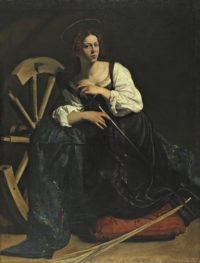 One of the greatest masterpieces in the collection of Madrid’s Museo Nacional Thyssen-Bornemisza is Saint Catherine of Alexandria by Michelangelo Merisi, also known as Caravaggio. Commissioned by his early patron Cardinal Francesco Maria del Monte around 1598, Saint Catherine is depicted in luxurious Renaissance garb kneeling next to the spiked breaking wheel that was supposed to kill her, the sword that did kill her after the former broke upon her touch and the martyr’s palm, all symbols of her martyrdom.
One of the greatest masterpieces in the collection of Madrid’s Museo Nacional Thyssen-Bornemisza is Saint Catherine of Alexandria by Michelangelo Merisi, also known as Caravaggio. Commissioned by his early patron Cardinal Francesco Maria del Monte around 1598, Saint Catherine is depicted in luxurious Renaissance garb kneeling next to the spiked breaking wheel that was supposed to kill her, the sword that did kill her after the former broke upon her touch and the martyr’s palm, all symbols of her martyrdom.
This painting and another commissioned by del Monte, The Lute Player, now in the Wildenstein Collection, are set in the same type of rooms as earlier works like The Fortune Teller and The Cardsharps, but the background walls are much more dense and inky 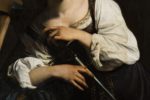 tones, the scuro half of the chiaroscuro effect that would become so inextricably associated with Caravaggio’s genius. The strong directional light illuminating Catherine’s face and upper body is the chiaro bit. He upped the contrast in this piece, using the light flesh tones and white blouse to make Saint Catherine stand out in the penumbra, creating dimension and depth.
tones, the scuro half of the chiaroscuro effect that would become so inextricably associated with Caravaggio’s genius. The strong directional light illuminating Catherine’s face and upper body is the chiaro bit. He upped the contrast in this piece, using the light flesh tones and white blouse to make Saint Catherine stand out in the penumbra, creating dimension and depth.
 Saint Catherine has been part of the Museo Nacional Thyssen-Bornemisza’s collection since 1934 when it was bought at a gallery in Lucerne after one of the Barberini family’s patrimony fire sales. Museum conservators have just completed a complex program of study, cleaning and restoration of the painting, returning to Catherine the full impact of Caravaggio’s mastery of light and shadow.
Saint Catherine has been part of the Museo Nacional Thyssen-Bornemisza’s collection since 1934 when it was bought at a gallery in Lucerne after one of the Barberini family’s patrimony fire sales. Museum conservators have just completed a complex program of study, cleaning and restoration of the painting, returning to Catherine the full impact of Caravaggio’s mastery of light and shadow.
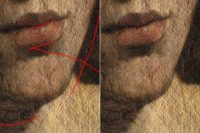 The primary focus of the work was the removal of many layers of varnish added to the work over the centuries. To ensure that original was preserved, microsamples of the paint were taken and analyzed to identify the materials Caravaggio used and assess their condition. Macrophotographs, raking light examination, X-rays and infrared reflectography were all used to reveal previously unseen details of the artist’s composition and technique. For example, raking light illuminated incisions in the first paint layer, a method Caravaggio used to figure out where to place the volumes (shapes, curves, lines) of the composition.
The primary focus of the work was the removal of many layers of varnish added to the work over the centuries. To ensure that original was preserved, microsamples of the paint were taken and analyzed to identify the materials Caravaggio used and assess their condition. Macrophotographs, raking light examination, X-rays and infrared reflectography were all used to reveal previously unseen details of the artist’s composition and technique. For example, raking light illuminated incisions in the first paint layer, a method Caravaggio used to figure out where to place the volumes (shapes, curves, lines) of the composition.
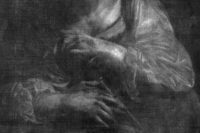 Conservators also discovered that Catherine’s dress started out red before the artist painted a dark charcoal grey over it. X-rays showed that Caravaggio changed his mind on hand placement too, as the saint’s left hand is veritably bristling with fingers underneath the top layer. The wheel is different as well, but that wasn’t a change in plan. Caravaggio drew the complete wheel first to make sure it would fit before painting over it to create the break representing Catherine’s miraculous destruction of the means of her martyrdom.
Conservators also discovered that Catherine’s dress started out red before the artist painted a dark charcoal grey over it. X-rays showed that Caravaggio changed his mind on hand placement too, as the saint’s left hand is veritably bristling with fingers underneath the top layer. The wheel is different as well, but that wasn’t a change in plan. Caravaggio drew the complete wheel first to make sure it would fit before painting over it to create the break representing Catherine’s miraculous destruction of the means of her martyrdom.
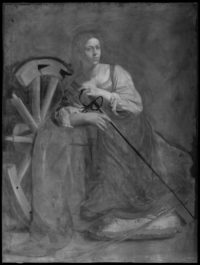 The deep blue of the robes was created by combining lapis lazuli, azurite grains, cochineal red, charcoal black, lead white and earth pigments. The lapis in particular was a very expensive ingredient, evidence of the financial support he got from the Cardinal.
The deep blue of the robes was created by combining lapis lazuli, azurite grains, cochineal red, charcoal black, lead white and earth pigments. The lapis in particular was a very expensive ingredient, evidence of the financial support he got from the Cardinal.
Discovering Caravaggio. Technical study and restoration of Saint Catherine of Alexandria is now on display at the Museo Nacional Thyssen-Bornemisza. The restoration is as much of a part of the exhibition as the masterpiece itself.
The show includes X-ray images and infrared reflectograms which illustrate the most interesting aspects of the work performed, explain the methods used, and attest to the excellent quality of the painting. It also features a video of the entire restoration process, the most significant discoveries, and interesting details of the painting.
With this exhibition the Museum, aware of the interest aroused by restoration work, sets out to familiarise visitors with the working methods used by restorers, who are essential to deciding on the most appropriate treatments in each case and a source of important information for art historians. Knowledge of the techniques and materials used by artists is essential to be able to decide on which processes to use to halt the deterioration of artworks. Discovering the most intimate aspects of artistic creation furthermore provides an insight into the artist’s mind and period, as well as better-grounded arguments for understanding the creative process.
The exhibition is a short one, just six months long. It opened December 17th and closes May 26th, 2019.
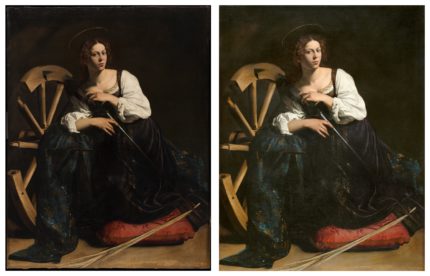
I can’t thank you enough for this post. Caravaggio is my favorite painter, and your treatise on his Saint Catherine is a joy to read.
Catherine generated an interesting legend:
https://infogalactic.com/info/Catherine_of_Alexandria
This is the lass after whom the firework is named.
The model is beautiful. I wonder if she was a lover of Caravaggio, though history seems to be confused about which side he batted for.
The severed heads, which paintings of the time seemed to require, are reckoned to be Caravaggio’s. Interesting psychology from a broth of a boy.